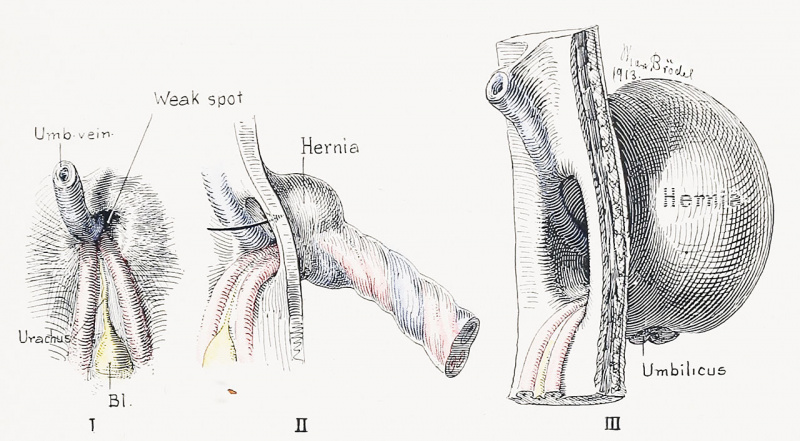File:Cullen1916 fig30.jpg

Original file (1,280 × 706 pixels, file size: 197 KB, MIME type: image/jpeg)
Fig. 30. Three Diagrams of the Umbilical Ring and its Significance in the Development of Ventral Hernia
I. Dissection of the umbilical ring in a human embryo eight months old, viewed from within. The peritoneum and subperitoneal connective tissue, containing a small amount of fat, have been carefully removed, exposing a funnelshaped opening above and to the right of the umbilical arteries. The umbilical vein lies to the left of this weak spot. The umbilical arteries are the strongest structures in the wall of the ring, and a hernial protrusion usually occurs above or to one side of them. Occasionally the umbilical vein is situated to the right of the ring, in which case the weak spot would be on the left side.
II. Side-view of the umbilical ring, showing the favorite position of the small hernial protrusion often seen in newborn babes.
III. A larger hernia, representing a later stage of the same type. Note how the umbilicus becomes lodged at the
lower portion of the hernial pouch.
| Historic Disclaimer - information about historic embryology pages |
|---|
| Pages where the terms "Historic" (textbooks, papers, people, recommendations) appear on this site, and sections within pages where this disclaimer appears, indicate that the content and scientific understanding are specific to the time of publication. This means that while some scientific descriptions are still accurate, the terminology and interpretation of the developmental mechanisms reflect the understanding at the time of original publication and those of the preceding periods, these terms, interpretations and recommendations may not reflect our current scientific understanding. (More? Embryology History | Historic Embryology Papers) |
- Figure Links: 1 Human embryo 0.7 mm | 2 Human embryo 1.7 mm | 3 Human embryo 2.5 mm | 4 Human embryo 3.5 mm | 5 Human embryo 5 mm | 6 Human embryo 7 mm | 7 Human embryo 7 mm | 8 Human embryo 10 mm | 9 Human embryo 12.5 mm | 10 Human embryo 10 mm | 11 Human embryo 23 mm | 12 Human embryo 3 cm | 13 Human embryo 4.5 cm sagittal | 14 Human Embryo 4.5 cm | 15 Human Embryo 5.2 cm | 16 Human Embryo 6.5 cm | 17 Human Embryo 7.5 cm | 18 Human Embryo 9 cm | 19 Human Embryo 10 cm | 20 Human Embryo 12 cm | 21 Human Embryo 12 cm | 22 Human Embryo 12 cm | 23 Human Embryo 12 cm Cord | 28 Fetus Five Months | 30 Ventral Heria | 31 Human Embryo 5.5 cm | 32 Term Human | 33 Term Human | [[Figures
Reference
Cullen TS. Embryology, anatomy, and diseases of the umbilicus together with diseases of the urachus. (1916) W. B. Saunders Company, Philadelphia And London.
Cite this page: Hill, M.A. (2024, April 28) Embryology Cullen1916 fig30.jpg. Retrieved from https://embryology.med.unsw.edu.au/embryology/index.php/File:Cullen1916_fig30.jpg
- © Dr Mark Hill 2024, UNSW Embryology ISBN: 978 0 7334 2609 4 - UNSW CRICOS Provider Code No. 00098G
File history
Click on a date/time to view the file as it appeared at that time.
| Date/Time | Thumbnail | Dimensions | User | Comment | |
|---|---|---|---|---|---|
| current | 14:06, 28 October 2018 |  | 1,280 × 706 (197 KB) | Z8600021 (talk | contribs) | |
| 14:03, 28 October 2018 |  | 2,072 × 1,478 (558 KB) | Z8600021 (talk | contribs) |
You cannot overwrite this file.
File usage
The following 2 pages use this file:
